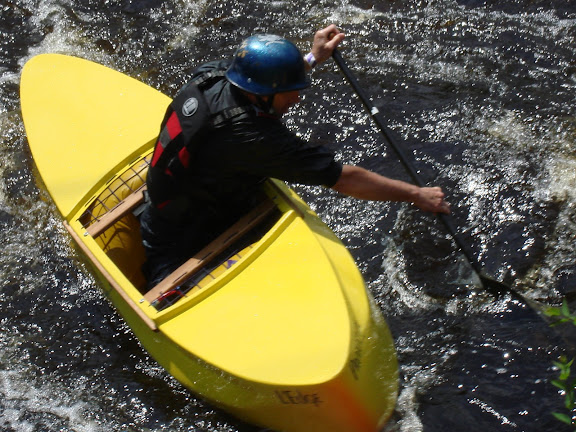the great gonzo wrote:philcanoe wrote:yarnellboat wrote:...- but I've never seen it recommend for a peel-out!

Pat.
Try it Pat, your missing out on a something special. 
It's probably my most used method of exiting an eddy. You'll peel out farther, be under more control than with the other lean, and when down pat (sic) or learned requires minimal strength. Excellent for use on the offside peel out, it's a real plus.
Huh? Maybe I am misunderstanding you here Phil, but if I peel out with some outside tilt, my bow edge grabs really fast and I do not go deep into the current, but turn quite fast, alsmost as fast as when doing an agressive bow/crossbow draw turn with the hull almost flat.
When I want to peel out deep into the current, particularly on big water with strong and turbulent eddylines (thing Grand Canyon, Thompson Canyon, Main Channel of the Ottawa at high water), then my preferred technique is the on- or offside gliding draw.
Start accelerating deep in the eddy with a conservative angle and inside tilt. Put in a last forward stroke on the downstream side (inside) as you are crossing the eddyline, finishing the forward stroke with a static draw at or slightly behind your hip and hold. The static draw at the hip will keep the bow of your boat from getting blown open too early. Then start gliding that on-or offside draw forward as you are ready to turn downstream into a bow draw position. This technique gets me really deep into the current without putting in any strokes after hitting the eddyline by simply using the water pressure on my blade and it's position relative to the pivot point of my boat to control my peel out. It feels a bit awkward the first time you use it on the offside, but as Rick (PierreLaPaddelle) and Bob (we'll c) can confirm, it works like a charm.
TGG!
Yes = I use the same draw.
(mind you this is open boat gibberish - not sure what this would do to a low volume C1)
To peel out - I just lean upstream a wee bit, allowing some water to grab the leading edge and thus utilize/maintain/exploiting the flipping action (that most people fear or expect). The boat is held upright with a opposing high brace....(as always protect shoulder - with top hand low in the box).... this brace is maintained as that
gliding draw you mentioned (really liked your description) . In practice it's like a ferry which you hold, and then when reaching your desired position somewhere out there in the current, a downward turn is allowed to happen or enacted.... I do the exact finishing part you described. In essence finishing the ferry, with a spin, s-turn, or more ferrying. And yes, it works well in big water like the G'Canyon, Ottawa, double digit New River, Wautauga (over the bridge), Little River Canyon (multiple feet), and heap big blownout creeks. Without riding the lean into a ferry, it would do as you mentioned, but the continued flipping motion and draw cancels out into a ferry. Same classic ferry forces - One force headed upriver (the flip), the Other force to the side (the draw), and the direction traveled in between the two forces (the boat).
In fact it works better in high water than the traditional one ever did, because the flipping factor just gets better. And that's what makes the whole thing work. If you think about it, by starting out leaning down you already have given up ground and are heading down stream instead of out into the current.. While if leaning upstream you are holding firm, and start ferrying very near where you started from. Of course this move requires using your core (in particular low body- thighs-knees) to control the boat, while your upper body handles to draw component, changing boat angle and lean much like you do with the other downstream lean. As you glide along on a draw (yes - you're using just one stroke) your thighs-knees-lower-back-buttocks drive the boat on the desired course. Which is the same way a boat should be driven with any other stroke. And most-especially when performing an eddy turn.
This is why the speed component is not the dominate factor, controlling the eddy turn (or peel out). If you believe it is the speed coming in, you're likely not throwing the boat around enough with your lower body. Yes the differential between slow in and fast in will increase the turn, but not near as much as what happens when using your body. I'll venture to say given the same setup, I'll spin faster this way than the plant the paddle and hang on guy ever will.

